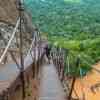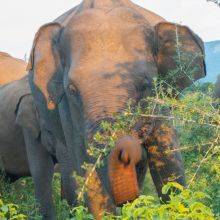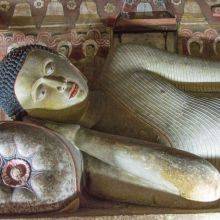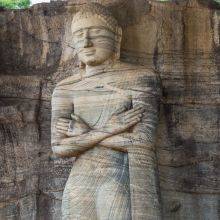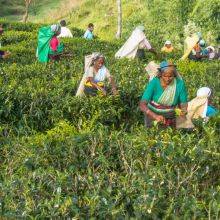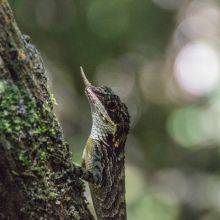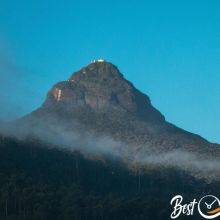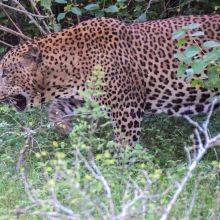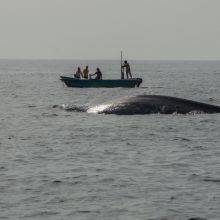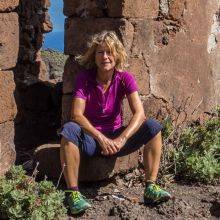When Is the Best Time
Sigiriya, or Lion's Rock, is one of the most stunning historical sites in Sri Lanka. It's also very popular and heavily crowded at times. I will show you how to avoid crowds and make the most out of your visit. Also, make sure to read my 8 must-know tips before your visit and the best spot to watch the sunset for awesome views of Sigiriya at the end of the article.
Avoiding the Crowds
It's significantly less crowded in the early morning and the late afternoon. If you want to avoid the midday heat and beat the crowds at the same time, be there at 7 a.m. sharp or visit in the late afternoon. Visiting later in the day (about 2 hours before they close) also gives you the perfect light for a good shot of Sigiriya Rock. Especially the intriguing fresco paintings are at their best in the late afternoon light. However, for a perfect photo, it needs to be sunny. Avoid weekends and public holidays if possible, as many local visitors are there in addition to foreign tourists. Overview of public holidays: Sri Lanka Public Holidays 2023.
Opening Hours - Entrance Fee
- Opening Hours are from 7 am - 5:30 pm.
- The entrance fee is costly; $ 30 in 2022 for foreigners. Your experience may get spoiled when you arrive at midday while sharing the place is packed with tourists.
- The resident fee is LKR 50, which is $ 0,25, but that is fair compared to their income.
Weather
Sigiriya is a year-round destination. Day temperatures range between 30-35°C, and night drop to 25-20°C. Showers can occur throughout the year! It is a tropical climate with a humidity of around 80 % most of the year.
Drier Season - January to September
It usually offers the most pleasant weather conditions between January and June, though April is slightly wetter. The drier season in this area starts in January and last until September. It is often overcast from June to August. From January to May, it's frequently sunny. We spent two days at Sigiriya in January, and the weather was quite nice.
Rainy Season - October to December
Humidity can be an issue, especially in the rainy season. October until December are the wettest months. Also, April experiences slightly more rain.
Helpful weather overview: Climate - Average Monthly Weather Sigiriya
Where to Stay Nearby
For me, the best hotel to explore Sigiriya with a spectacular view is the Sigiriya Hotel, just a 15 minutes walk - 1 km to the entrance of Lion's Rock. It looks even better than in my picture. The breakfast buffet was plentiful and perfect for a good start.
Hotels/Lodges: There are many excellent accommodations nearby. We loved ours, which is nearby. But you can also browse for the best hotels and lodges here: Sigiriya Rock - Accommodations
Best Months to Visit
Location and Tips

Rising almost 200 meters (660 ft) from flat plains, this ancient rock fortress provides visitors with one of the most dramatic views in Sri Lanka. Often called the 8th wonder of the world, Sigiriya became a UNESCO World Heritage Site in 1982. It's one of the best-preserved examples of ancient urban planning. The stunning height on which a palace complex was built amazes even today's architects and engineers.
Though the entrance fee is a bit pricey for foreigners, it’s utterly worth it. We organized a guide by the hotel. He recommended the afternoon with better light and fewer tourists and he was right. Before climbing to the top make a stop at the restrooms. There isn’t any on the rock itself. The museum at the entrance is informative. Nature and wildlife are also beautiful.
Sigiriya Location
'The Ancient City of Sigiriya' is located in the heart of the cultural triangle. It is formed by Anuradhapura and Mihintale in the north, by Polonnaruwa and Sigiriya to the southeast with Dambulla in the middle and to the south by Kandy and Matale Vihara. The triangle includes five of the eight world heritage sites in Sri Lanka.
Volcanic Formation
The massive rock column is a volcanic plug formed over 2 billion years ago. Volcanic plugs are created when magma hardens inside a vent on an active volcano. After the volcanic activity ceased, the plug forms through erosion: The surrounding rock is removed over time by wind and rain, while the hard volcanic plug material remains. As a result, a distinctive upright landform is left.
5 Facts About the Sigiriya's History
- The first clear signs of inhabitants at this structure date back to the 3rd century BC (= 300 years before year 1). Apparently, monks and ascetics lived there in rock shelters and caves. There is also evidence that the area was occupied even earlier, almost 5000 years ago.
- However, the formation of sophisticated architecture happened later when King Kashyapa (reigned 477–495) built a palace on the summit of the rock during the 5th century AD. It is said that it served him as a safeguard against enemies as well as a pleasure palace. Sigiriya was developed into a fortress and a complex city surrounding the rock. Most of the constructions on the rock summit and around it, including defensive structures, palaces, and garden constructions, date from the period of the king's reign. After the king was defeated in 495, he died a violent death.
- Then Sigiriya was converted into a Buddhist monastery complex. Monks used it until the 14th century. After this period, no records are found on Sigiriya for a very long time.
- Although some archaeological work began during the 19th century, only British explorer John Still discovered important parts of the site in 1907.
- In 1982 Sigiriya became a UNESCO World Heritage Site; as one of the best-preserved examples of ancient urban planning. Today it is an impressive ancient monument. The ruins show how a rock was once transformed into a complex fortress and palace.
Intriguing Frescoes
Some of the most magnificent ancient frescoes in the world are found at Sigiriya. Fresco means 'fresh' in Italian and is the oldest known painting technique. The painting becomes an integral part of the wall, resulting in extreme durability—the earliest known examples of frescoes date from the Egyptian culture 2600 BC.
The Sigiriya Frescoes are found in the Cobra Hood Cave, which can be reached after climbing up on a narrow spiral staircase (see below). They decorate the walls with colourful and intriguing art. Painted over 1,500 years ago during the reign of King Kashyapa. The frescoes depict women (maybe the king's wives) of the royal court performing various tasks, like showering flowers upon the humans below. It is estimated that there were more than 500 paintings, but due to the tropical climate, most of the frescoes got destroyed. Only 19 of the paintings survived today. Most visitors say that these are the most stunning frescoes they have ever seen. It is said that you are not allowed to photograph them. However, we were only told not to use a flashlight during our visit.
Garden Complex
Sigiriya in Sri Lanka is not only the rock itself but the remains of a complex fortress, including several gardens with ponds, canals, alleys, and fountains: Sigiriya Lion Rock Complex. There were almost 100 swimming pools and ponds as well as an incredible series of fountains. Thus the gardens are an important part of this historic site. It is said that they are among the oldest landscaped gardens on our planet. They are divided into three linked forms: Symmetrically planned water gardens, boulder gardens, and terraced gardens.
Probably the most interesting construction from an architectural and engineering point of view is the gravity-fed fountains in the water gardens. They were built over 1600 years ago and displayed a very sophisticated hydraulic technology dating from an Early Historic Period. Even today, the fountains still function to a small degree and can be experienced during the rainy season from October to December.
Climbing Sigiriya Rock
After receiving your entrance tickets, you can roam the area, including the garden complex. However, we decided to start climbing the rock immediately. The climb to the top (about 1200 steps) takes about 1 and 1,5 hours, depending on your fitness, age, the crowds and how fast you'd like to go. Due to the steepness and humidity, it can become quite a strenuous climb. However, the first few stairways are fairly easy ones in the Fountain Gardens and the Boulder Gardens. A number of caves and small platforms can be spotted along the way there. Then the first challenge starts with a series of steep stairs in the Terraced Gardens and a grand staircase leading up to the Mirror Wall.
Besides the frescoes, the Mirror Wall is one of the most amazing aspects of Sigiriya. During the reign of King Kashyapa, the wall was carefully polished in order to produce reflections of the king. Now the plaster is gone, and it is painted with inscriptions, including poems, left by visitors. The oldest inscriptions date back to the 8th century, proving that Sigiriya has been a 'tourist destination' for quite a while. Today there are signs which warn visitors not to add their own inscriptions. The next stop is probably the highlight of your visit: The intriguing Frescoes. A separate and very narrow spiral staircase can reach the fresco paintings. You ascend the steep stairs about 20 m and later descend back down before continuing to the next part.
Why is Sigiriya Called Lion Rock?
On a small plateau, halfway up to the top of the rock, is a portal that looks like an enormous lion. This is the reason why Sigiriya is also named Lion Rock.
From here, the "lion" staircase is carved out from a rock and continues on newly constructed iron steps to the top. A climb to the top of the rock is worth the effort. You see the ruins of the former palace. And the view from the top is mesmerizing.
On the summit of Sigiriya, you'll realize that this wasn't just a simple palace the king built. Instead, it was a collection of fascinating buildings, pavilions, tropical gardens and ponds. It is said that the palace on the top was only used in summer. During the wet season, the king retreated to a palace at the bottom of the rock.
8 Must-Know Tips
- A Guide Is Not Needed but Helpful
There are many guides roaming around the entrance area offering their services. It's not necessary at all to use one. All paths are clear and well explained via signs. However, a guide for the area (driving to the sites) is highly recommended. - Climb to the Very Top
Unless you have a severe fear of heights or your physical condition doesn't allow it: Climb all the way up to the top! It's definitely worth it. Some visitors stop at the lion plateau and then head back. It can be a tough climb to the top, but the views from there are just stunning. - Bring Plenty of Water
It's hot, and you definitely get thirsty when climbing to the top. It can get strenuous due to its steepness and humidity. - Dodge the Crowds
It's a much more enjoyable climb without the tourist crowds. Follow my tips from above and be very early when virtually no other visitors are around. Alternatively, get there later in the afternoon. - Best Light for Perfect Shots
The best time of the day for stunning pictures of Lions Rock is in the afternoon. We were glad our guide told us the day before. - Don't Rush
Follow my tips above and start early or late to avoid crowds. That way, you can take your time and enjoy the climb. There are so many excellent photo opportunities on your way to the top. While rushing through, you'd probably miss these. - Beware of the Hornets
There are reports that hornets are occasionally aggressive and sting people on the top of the rock or on their way up. It might be dangerous for people with allergies and young children. In that case, wear appropriate clothing and don't make too much noise. - Avoid the Monkeys
There are lots of cheeky macaque monkeys. Although they seem cute at first, you should definitely keep your distance. These little thieves can steal almost everything: food, bags, sunglasses etc. They are annoying.
Top Spot to Watch the Sunset
Looking for a magnificent view of Sigiriya for the sunset? This tip is from Jenni, who has been travelling already for two years with her family. They hiked to the top of Pidurangala in the afternoon. It takes less than half an hour to reach the summit. The entrance fee is just $3 instead of $30 at Sigiriya. Bring a headlamp for the way back.
Noteworthy
A part of the original Duran Duran music video 'Save a Prayer' was shot on top of Sigiriya Rock in 1982: 'Save a Prayer' by Duran Duran
Do you want to obtain the usage right for my images? Contact me, but I will take action against picture theft.























